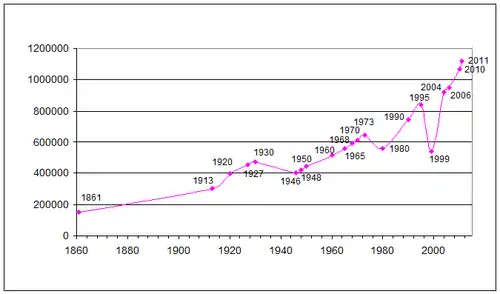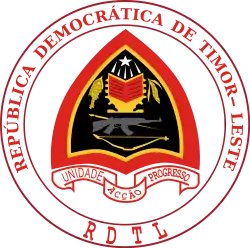Demographics of East Timor
This article is about the demographic features of the population of East Timor, including population density, ethnicity, education level, health of the populace, economic status, religious affiliations and other aspects of the population.


Vital statistics
UN estimates [1]
| Period | Live births per year | Deaths per year | Natural change per year | CBR1 | CDR1 | NC1 | TFR1 | IMR1 |
|---|---|---|---|---|---|---|---|---|
| 1950–1955 | 21 000 | 15 000 | 5 000 | 46.5 | 34.3 | 12.2 | 6.44 | 264.4 |
| 1955–1960 | 22 000 | 15 000 | 7 000 | 46.0 | 30.9 | 15.1 | 6.35 | 241.6 |
| 1960–1965 | 24 000 | 15 000 | 9 000 | 45.9 | 28.0 | 17.8 | 6.37 | 220.7 |
| 1965–1970 | 25 000 | 15 000 | 11 000 | 44.2 | 25.2 | 19.0 | 6.16 | 201.1 |
| 1970–1975 | 25 000 | 14 000 | 11 000 | 40.0 | 22.2 | 17.8 | 5.54 | 183.3 |
| 1975–1980 | 21 000 | 18 000 | 3 000 | 33.0 | 28.2 | 4.9 | 4.31 | 253.4 |
| 1980–1985 | 27 000 | 14 000 | 14 000 | 44.0 | 22.0 | 22.0 | 5.39 | 183.5 |
| 1985–1990 | 30 000 | 14 000 | 16 000 | 42.1 | 19.3 | 22.7 | 5.21 | 161.0 |
| 1990–1995 | 35 000 | 13 000 | 23 000 | 44.5 | 15.9 | 28.6 | 5.69 | 129.0 |
| 1995–2000 | 39 000 | 11 000 | 28 000 | 46.1 | 12.9 | 33.2 | 7.01 | 100.6 |
| 2000–2005 | 37 000 | 9 000 | 28 000 | 40.4 | 10.0 | 30.4 | 6.96 | 78.9 |
| 2005–2010 | 42 000 | 9 000 | 33 000 | 39.4 | 8.7 | 30.7 | 6.53 | 66.8 |
| 1 CBR = crude birth rate (per 1000); CDR = crude death rate (per 1000); NC = natural change (per 1000); TFR = total fertility rate (number of children per woman); IMR = infant mortality rate per 1000 births | ||||||||
Fertility and Births
Total Fertility Rate (TFR) and Crude Birth Rate (CBR):[2]
| Year | CBR (Total) | TFR (Total) | CBR (Urban) | TFR (Urban) | CBR (Rural) | TFR (Rural) |
|---|---|---|---|---|---|---|
| 2003 | 52.1 | 7.8 | 50.5 | 7.4 | ||
| 2009–2010 | 33.2 | 5.7 (5.1) | 33.1 | 4.9 (4.2) | 33.2 | 6.0 (5.4) |
| 2016 | 26.8 | 4.2 (3.5) | 28.4 | 3.5 (3.0) | 26.2 | 4.6 (3.8) |
Fertility rate by municipality
Aileu Municipality and Ainaro Municipality have the highest fertility rate with 5.5 children per woman, followed by Ermera Municipality with 5.4 children per woman.[3]
| Municipality | Fertility rate in 2004 | Fertility rate in 2010 | Fertility rate in 2015 | Decline between 2004 and 2015 |
|---|---|---|---|---|
| 6.7 | 5.3 | 3.9 | ||
| 7.1 | 6.2 | 5.1 | ||
| 7.0 | 5.6 | 4.7 | ||
| 7.3 | 5.6 | 4.9 | ||
| 6.7 | 5.6 | 4.6 | ||
| 8.4 | 7.0 | 5.5 | ||
| 7.7 | 6.4 | 5.2 | ||
| 6.9 | 5.9 | 4.7 | ||
| 6.9 | 5.8 | 4.7 | ||
| 6.3 | 5.3 | 4.6 | ||
| 8.2 | 6.9 | 5.4 | ||
| 8.3 | 6.4 | 5.5 | ||
| 6.9 | 5.2 | 4.2 | ||
| 7.2 | 5.9 | 4.7 |
Between 2014/15, around 43.5% of the births occurred in a health facility, up from 36.3% in 2010/11. This percentage varies widely from 77.5% in Dili Municipality to only 15.1% of all births in Ermera Municipality.
Life expectancy at birth[4]
Average life expectancy at age 0 of the total population.
| Period | Life expectancy in Years |
Period | Life expectancy in Years |
|---|---|---|---|
| 1950–1955 | 30.0 | 1985–1990 | 46.5 |
| 1955–1960 | 32.5 | 1990–1995 | 50.5 |
| 1960–1965 | 35.0 | 1995–2000 | 57.0 |
| 1965–1970 | 37.5 | 2000–2005 | 61.5 |
| 1970–1975 | 40.0 | 2005–2010 | 66.4 |
| 1975–1980 | 31.2 | 2010–2015 | 67.7 |
| 1980–1985 | 39.9 |
Population pyramids[5]
Census (11/07/2015) :
| Age group | Male | Female | Total | % |
|---|---|---|---|---|
| Total | 601 112 | 582 531 | 1 183 643 | 100 |
| 0-4 | 77 896 | 72 410 | 150 306 | 12.70 |
| 5-9 | 80 377 | 75 705 | 156 082 | 13.19 |
| 10-14 | 80 721 | 75 548 | 156 269 | 13.20 |
| 15-19 | 69 839 | 67 033 | 136 872 | 11.56 |
| 20-24 | 52 759 | 54 244 | 107 003 | 9.04 |
| 25-29 | 45 486 | 47 464 | 92 950 | 7.85 |
| 30-34 | 35 934 | 36 461 | 72 395 | 6.12 |
| 35-39 | 24 245 | 24 645 | 48 890 | 4.13 |
| 40-44 | 29 097 | 26 779 | 55 876 | 4.72 |
| 45-49 | 25 044 | 22 274 | 47 318 | 4.00 |
| 50-54 | 18 661 | 16 776 | 35 437 | 2.99 |
| 55-59 | 14 436 | 12 867 | 27 303 | 2.31 |
| 60-64 | 13 864 | 14 516 | 28 380 | 2.40 |
| 65-69 | 14 611 | 16 427 | 31 038 | 2.62 |
| 70-74 | 8 949 | 9 204 | 18 153 | 1.53 |
| 75-79 | 4 862 | 5 009 | 9 961 | 0.84 |
| 80-84 | 2 399 | 2 798 | 5 197 | 0.44 |
| 85+ | 1 932 | 2 281 | 4 213 | 0.36 |
| Age group | Male | Female | Total | Percent |
|---|---|---|---|---|
| 0-14 | 238 994 | 223 663 | 462 657 | 39.09 |
| 15-64 | 329 365 | 323 059 | 652 334 | 55.11 |
| 65+ | 32 753 | 35 809 | 68 562 | 5.79 |
Median age
In 2015 the median age of the population was 19.6 years old. The population living in rural areas is slightly younger (19.0) compared to the population living in urban areas (20.6). Ainaro Municipality has the lowest median age with 17.3 years, while Dili Municipality has the highest median age with 21.2 years.[6]
CIA World Factbook demographic statistics
The following demographic statistics are from the CIA World Factbook [7]
Population
- 1,242,000 (2017)
Birth rate
- 33.4 births/1,000 population (2017 est.)
Death rate
- 5.9 deaths/1,000 population (2017 est.)
Population growth rate
- 2.36% (2017 est.)
Net migration rate
- -3.9 migrant(s)/1,000 population (2017 est.)
Infant mortality rate
- total: 35.1 deaths/1,000 live births (2017 est)
Life expectancy at birth
- total population: 68.4 years
- male: 66.8 years
- female: 70.1 years (2017 est.)
Total fertility rate
- 4.97 children born/woman (2017 est)
Nationality
- noun: East Timorese
- adjective: East Timorese
Ethnic groups
- Austronesian (Malayo-Polynesian), Papuan, small Chinese and European Portuguese descent.
Religions
- Roman Catholic 97.6% (2015 est.)
- Protestant/Evangelical 2% (2015 est.)
- Islam 0.2% (2015 est.)
- Other 0.2% (2015 est.)
Languages
- Tetum (official), Portuguese (official), Indonesian (constitutionally defined as a 'working language') and English (constitutionally defined as a 'working language')).
- Note: There are a total of about 16 indigenous languages, of which Tetum, Galole, Mambae, and Kemak are spoken by significant numbers of people. The Tetum language is partially influenced by European languages, particularly Portuguese, a legacy of Portuguese rule.
Literacy
- definition: age 15 and over can read and write
- total population: 67.5% (2015 est.)
- male: 71.5%
- female: 63.4%
After achieving independence, East Timor had a high illiteracy rate, with 55% of women and 46% of men illiterate. Approximately 18% of the adult population had achieved secondary education and approximately 1.4% of them had an academic degree or achieved other higher education, nearly all of whom resided in urban areas, primarily the capital Dili. Attempts to improve education services face challenges in the form of a lack of educated and experienced teachers. Continuing high fertility rates also translates to greater strains on the government to increase education budgets. The United Nations (UN) has assisted in rebuilding the education system increasing the number of teachers and rehabilitating many schools, leading to a rapid increase in school enrollment. However, problems remain as the quality of education was deemed secondary to the need to increase enrollment in East Timor.
Another problem faced in increasing the education levels includes the economic conditions of the population. With high proportions of the population living below the poverty line and large households with many children, the direct costs of schooling is significant for families. Lack of monetary resources to send children to school imposes greater difficulty in increasing enrollment rates in schools. In addition, parents may be disillusioned with the poor quality of education and thus may not even be interested to send their children to schools. Much remains to be done to establish a new curriculum and support it with texts and learning materials to improve the quality of education. The variety of language spoken also means a large number of children do not speak the language of instruction – Portuguese – and this causes them to be marginalised. Many teachers do not speak Portuguese.
The inaccessibility of schools with proper facilities adds to the problem of providing adequate education to the population. Schools are located far away from homes and, coupled with the poor conditions of schools, may inhibit the early enrollment of children or lead to early drop-outs. Schools in rural areas face substantial lack of facilities to render them safe. As for the schools in urban areas, significant urban migration has meant that the supply of schools in urban areas have not managed to keep up with the increasing demand; leading to overcrowding in urban schools.
Besides the problems faced at the level of the individual households and the schools, problems in the governance and management of education are also significant impediments to raising education levels in East Timor. The lack of qualified personnel in critical positions within the education ministry has meant that overall policy making, planning and management functions are restricted. Management of schools at the district level is often under-qualified due to the lack of formal training. Today therefore, East Timor faces many challenges in increasing the literacy rates of their people.
References
| Wikimedia Commons has media related to Demographics of East Timor. |
- World Population Prospects: The 2010 Revision
- http://microdata.worldbank.org/index.php/catalog/dhs#_r=&collection=&country=&dtype=&from=1890&page=15&ps=&sk=&sort_by=nation&sort_order=&to=2014&topic=&view=s&vk=
- "World Population Prospects - Population Division - United Nations". esa.un.org. Retrieved 2018-08-26.
- "Population by Age & Sex". Statistics Timor-Leste General Directorate of Statistics. Statistics Timor-Leste. Retrieved 29 January 2020.
- 2015 Timor-Leste Population and Housing Census – Data Sheet
- "East & Southeast Asia :: TIMOR-LESTE". CIA The World Factbook.
